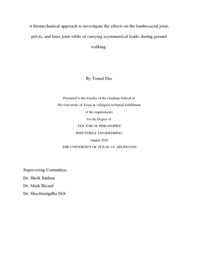| dc.description.abstract | Spinal pain is reasonably considered among the expensive and impairing problems critically disturbing the health of individuals, especially the workforce, in industrially developed countries (Steele et al., 2003). The pain adversely affecting the lumbar region or pelvis is typically considered as low back pain. As per the National Institute of Neurological Disorder and Stroke, around 80 percent of grown-ups encounter spinal pain eventually in the course of their lifetime. The possible risk factors include age, fitness level, genetics, weight gain, occupational risk factors such as having a job that expects someone to do lifting, carrying, pushing, pulling, distorting the spinal column, and backpack overload in children, etc.(Low Back Pain Fact Sheet | National Institute of Neurological Disorders and Stroke, n.d.). Many lifting studies and backpack carrying studies have adequately identified carrying a load as an activity that contributes to possible risk to the problems in the lumbar spine (Cholewicki et al., 1991; Daniel H.K. Chow et al., 2005; Goh et al., 1998). Most of the published studies have investigated school-going children, recreational hikers, or military personnel with a heavy backpack. However, the present literature lacks the information of precisely locating the lumbosacral joint coordinate system and the possible effects on the lumbosacral joint while carrying a one strap electrical and maintenance tool bag which moves or swings side to side as the carrier moves. Backpacks, used for carrying books, stationery items, or items used by recreational hikers, are typically stable but the one strap tool bag has to be suspended from the shoulder. This suspension may result in the swing of the bag from side to side, or it may strike the lateral side of the pelvis while walking. Even if the carrier wants to stabilize the tool bag, he/she will have to hold the bag while walking, which results in restricting the arm swing. Another way to carry the tool bag is to hold the handle of the tool bag if it has any. Even in this case, the arm will have limited swing. Therefore, this study aims to develop a method that can investigate the effects on the spine, pelvis, and knee from carrying loads asymmetrically (on one shoulder and in one hand) during ground walking.
Objective: The objective of this experiment is to develop a method for the evaluation of kinetics and kinematics variables to assess the strain level of the participant while carrying asymmetrical loads during ground walking. This method aims to
• Identify and analyze the Lumbosacral joint (L5-S1) disc compression and shear force
• Identify and analyze the pelvis obliquity, tilt, and rotation
• Identify and analyze the knee joint compression | |
| dc.subject | Biomechanical model, kinetics, kinematics, Lumbosacral joint, knee joint, hip joint, pelvis, compression force, shear force, L5-S1 disc | |


